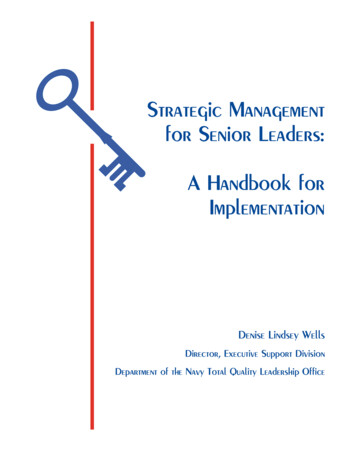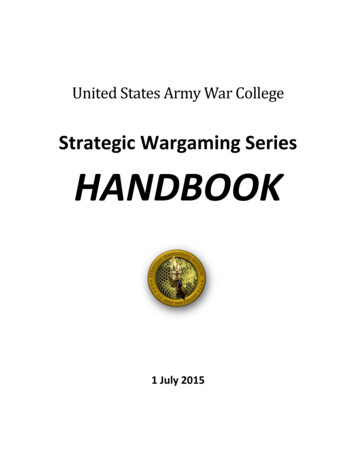
Transcription
Strategic Managementfor Senior Leaders:A Handbook forImplementationDenise Lindsey WellsDirector, Executive Support DivisionDepartment of the Navy Total Quality Leadership Office
About the TQL OfficeThe mission of the Total Quality Leadership (TQL) Office, Office of the UnderSecretary of the Navy, is to assist the Department of the Navy (DON) leadersin their quality-focused improvement efforts. The TQL Office also providestechnical advice to a number of organizations inside and outside government.The TQL Office has responsibilities in six key areas:Information andCommunicationThe TQL Office educates the DON about TQL policies and initiatives throughthe TQLeader and through articles, reports, and presentations at conferencesand meetings. It has developed a computer-based quality information network to facilitate communication with DON organizations.AssessmentSystems are needed to assess and enhance TQL implementation in the DON.The TQL Office designs and develops feedback mechanisms in support ofmission accomplishment. It also develops new approaches to improvingorganizational effectiveness.ConsultantServicesTQL Office members provide technical advice to the Under Secretary of theNavy and other senior DON leaders on the application of TQL principles andmethods within the DON and on strategic planning. Advice may also take theform of recommendations on implementing new laws, such as the GovernmentPerformance and Results Act, as well as on related initiatives.Educationand TrainingThe TQL Office is responsible for ensuring the technical accuracy of the DONTQL curriculum. Having overseen the design and development of the courses,the staff now advises on the integration of TQL material into training pipelines.The TQL Office continues to publish handbooks and other publications on allaspects of organizational change and to design new courses.Networkingand LiaisonThe TQL Office has much to share with other organizations, both governmentand private, and much to learn from them. Staff members participate inTQL-related networks and professional organizations.NewTechnologiesTechnology can provide critical support to DON quality improvement efforts.The job of the TQL Office is to assess new technologies related to organizational change and process improvement and translate them into applicationsfor the DON.
ForewordStrategic Management for Senior Leaders: A Handbook for Implementation has been developed as a companion volume to A Handbook forStrategic Planning (Department of the Navy Total Quality LeadershipOffice Publication No. 94-02). These handbooks were designed to assistDepartment of the Navy (DON) executives, Commanding Officers, TotalQuality Leadership (TQL) coordinators, and strategic planning facilitatorsin leading the strategic management process.Using A Handbook for Strategic Planning, the senior leadership team cancomplete most of the planning work by developing the organization svision, mission, guiding principles, strategic goals, strategies, and objectives. The next steps are to complete the planning work, publish, deploy,implement, measure, and evaluate the plan. Strategic Management forSenior Leaders: A Handbook for Implementation continues this process,offering suggestions on these steps.These suggestions derive from lessons learned during extensive work withclient organizations in developing, deploying, and implementing strategicplans. This information has been supplemented by research that includedpersonal interviews with DON and other government leaders who haveled strategic management efforts within their organizations. Therefore,this handbook should be considered a guideline to help leaders makechoices; it is not intended to be directive.Each organization has its own distinctive culture and mission. However,there are lessons learned and successful strategies that are common tothem all. This handbook brings together these strategies and lessons sothat senior leaders can apply them within their own organizations.The ability to lead organizations into the future is a new skill for mostsenior leaders. These are people who have a mission to perform and abusiness to manage. Such responsibilities leave little time to think aboutStrategic Management for Senior Leaders: A Handbook for Implementation i
the future, let alone put plans into action to reach that future. Yet, strategic management requires dedication and commitment on the part of thesenior leaders to create the vision of the future. Then they must create themechanisms and commit the resources to achieve that future. This handbook will help them go beyond planning and use their strategic plans tochange the way they do business.The principal research for Strategic Management for Senior Leaders: AHandbook for Implementation was done by a Logicon Syscon Corporation team (under subcontract to K.W. Tunnell Co., Inc., contract numberGS-22F-0096B). I especially want to recognize the efforts of Ms. KathyBurks, whose strategic planning expertise contributed to the success ofthis project. We hope readers find this handbook useful as they continueto lead their organizations into the future.Linda M. Doherty, Ph.D.DirectorDepartment of the Navy Total Quality Leadership Office ii Strategic Management for Senior Leaders: A Handbook for Implementation
ContentsForeword . iAcknowledgments . viiHow to Use this Handbook. xiSection I: Guidance. 1An Introduction to Strategic Management . 3Phase I Deployment: Completing the Strategic Plan . 9Keys to Success . 9Assign roles and responsibilities .10Establish priorities .17Involve mid-level management as active participants.18Think it through decide how to manage implementation. 21Charge mid-level management with aligninglower-level plans .23Make careful choices about the contents of the planand the form it will take .23Phase II Deployment: Communicating the Strategic Plan . 27Keys to Success . 27Assign roles and responsibilities .28Communicate the plan constantly and consistently . 29Recognize the change process.34Help people through the change process .35Strategic Management for Senior Leaders: A Handbook for Implementation iii
Implementing the Strategic Plan . 39Keys to Success .40Assign roles and responsibilities .41Involve senior leaders . 45Define an infrastructure .46Link goal groups .49Phase integration of implementation actions with workload .50Involve everyone within the organization. 52Allocate resources for implementation .55Manage the change process . 58Evaluate results . 60Share lessons learned; acknowledge successesthrough open and frequent communication . 61Strategic Measurement . 63Keys to Success .65Assign roles and responsibilities .65Use measurement to understand the organization . 69Use measurement to provide a consistent viewpointfrom which to gauge performance . 72Use measurement to provide an integrated, focusedview of the future .78Use measurement to communicate policy(new strategic direction) .79Update the measurement system .81Use measurement to provide quality feedback to thestrategic management process .82 iv Strategic Management for Senior Leaders: A Handbook for Implementation
Revisiting the Strategic Plan . 85Keys to Success .85Assign roles and responsibilities .86Recognize when to update the plan . 87Modify strategic planning process to accommodate themore mature organization .89Incorporate new leaders into the strategic planning process .91Integrate measurement with strategic planning .93Use experienced strategic planning facilitators .94Section II: Case Studies . 95Case Studies: Strategic Plans at Work . 97Naval Air Station, Barbers Point . 99Naval Air Facility Washington . 109United States Military Entrance Processing Command .121Center for Veterinary Medicine. 133Section III: Appendix . A-1Glossary . A-3Bibliography . A-9About the Author. A-15Strategic Management for Senior Leaders: A Handbook for Implementation v
vi Strategic Management for Senior Leaders: A Handbook for Implementation
AcknowledgementsI want to thank the following people and organizations who contributedto this handbook by agreeing to participate in our research. They participated in extensive interviews and provided documentation from their ownstrategic management efforts. Their input, advice, and lessons learned,both successes and failures, have been incorporated into this documentso that we may all apply better strategic management processes in ourorganizations. Special thanks is extended to those who participated inthe Case Studies by sharing the details of their strategies and results.Department ofthe NavyOrganizationsAEGIS Training Center, Dahlgren, VACAPT Gary Storm, Commanding OfficerLCDR Mike Church, Total Quality CoordinatorLuke Miller, Technical DirectorBranch Medical Center Oceana, Virginia Beach, VACDR V. M. Wilson, Commanding OfficerLT Matt Newton, Total Quality CoordinatorDASN Force Support and Families, Washington, DCYvonne Harrison, Former Deputy Assistant Secretaryof the Navy for Force Support and FamiliesFleet Training Command, Virginia Beach, VACAPT Earl Fought, Commanding OfficerJune Wolfe, Total Quality CoordinatorHeadquarters Battalion, Headquarters Marine Corps, Washington, DCCOL Kephart, Commanding OfficerLCOL Robert Dozier, Executive OfficerTerry Adams, Total Quality CoordinatorMarine Barracks, Washington, DCCOL David Dotterrer, Commanding OfficerLCOL Mike Kessler, Executive OfficerStrategic Management for Senior Leaders: A Handbook for Implementation vii
Marine Corps Multi-Commodity Maintenance Center, Barstow, CACol. Larkin Conaster, Commanding OfficerJoann Bond, Total Quality CoordinatorMike Burke, Total Quality FacilitatorMarine Corps University, Quantico, VACOL Hoeft, Commanding OfficerLCOL Bud Meador, Total Quality CoordinatorNaval Air Facility, Andrews Air Force Base, Washington, DCCAPT Randall Suratt, Commanding OfficerATC Robert Chandler, Total Quality CoordinatorNaval Air Station, Barbers Point, HICAPT Edward Waller, Commanding OfficerLCDR Lou Mosier, Total Quality CoordinatorNaval Air Station, Miramar, CACAPT R. L. Casey, Commanding OfficerMartin (Gene) Hepler, Total Quality CoordinatorNaval Dental Center, San Diego, CACDR Leary, Total Quality CoordinatorNaval Facilities Engineering Service Center, Port Hueneme, CACAPT John Collins, Commanding OfficerSteve Smuck, Total Quality CoordinatorNaval Reserve Force, New Orleans, LAJan Bowen, Total Quality CoordinatorNaval Security Group, Chesapeake, VACAPT Sharon Peyronel, Commanding OfficerCTMCS (AW) Patricia Nolan, Total Quality CoordinatorNaval Station, Mayport, FLCAPT Scott Cantfil, Commanding OfficerDiane Shepherd, Total Quality CoordinatorNaval Undersea Warfare Center, Keyport, WACAPT Dennis Gibbs, Commanding OfficerDallas Likens, Executive DirectorMike Kelf, Strategic Plan LeaderJohn Ebert, Total Quality Coordinator viii Strategic Management for Senior Leaders: A Handbook for Implementation
Program Executive Office, Surface Combatants/AEGIS Program,Washington, DCJohn Kuesters, Deputy AEGIS Program ManagerCAPT Grey Glover, Chief of StaffShore Intermediate Maintenance Activity, Portsmouth, VACDR Paul Clausen, Jr., Commanding OfficerMRCS (SW) Elvis Jefferson, Total Quality CoordinatorShore Intermediate Maintenance Activity, San Diego, CACAPT Gary Bier, Commanding OfficerJoyce Ward, Total Quality CoordinatorDepartmentof puty Secretary of Defense, Personnel Support,
vision, mission, guiding principles, strategic goals, strategies, and objec-tives. The next steps are to complete the planning work, publish, deploy, implement, measure, and evaluate the plan. Strategic Management for Senior Leaders: A Handbook for Implementation continues this process, offering suggestions on these steps.File Size: 940KBPage Count: 173











